PUBH6002: Environmental Risk Assessment of Food Safety in Australia
VerifiedAdded on 2023/06/09
|13
|2343
|353
Report
AI Summary
This report provides an environmental risk assessment of food safety in Australia, utilizing the DPSEEA framework to analyze driving forces, pressures, state changes, exposures, effects, and social, political, and economic influences on food safety. It highlights the roles of various health agencies, legislative and regulatory measures at federal, state, and local government levels in maintaining environmental health and ensuring food safety standards. The report identifies key issues such as population growth, resource scarcity, greenhouse gas emissions, soil contamination, and climate change, and their impact on food production and human health. Furthermore, it discusses policies and hazard management strategies implemented by the Australian government to mitigate these risks and improve food safety outcomes.
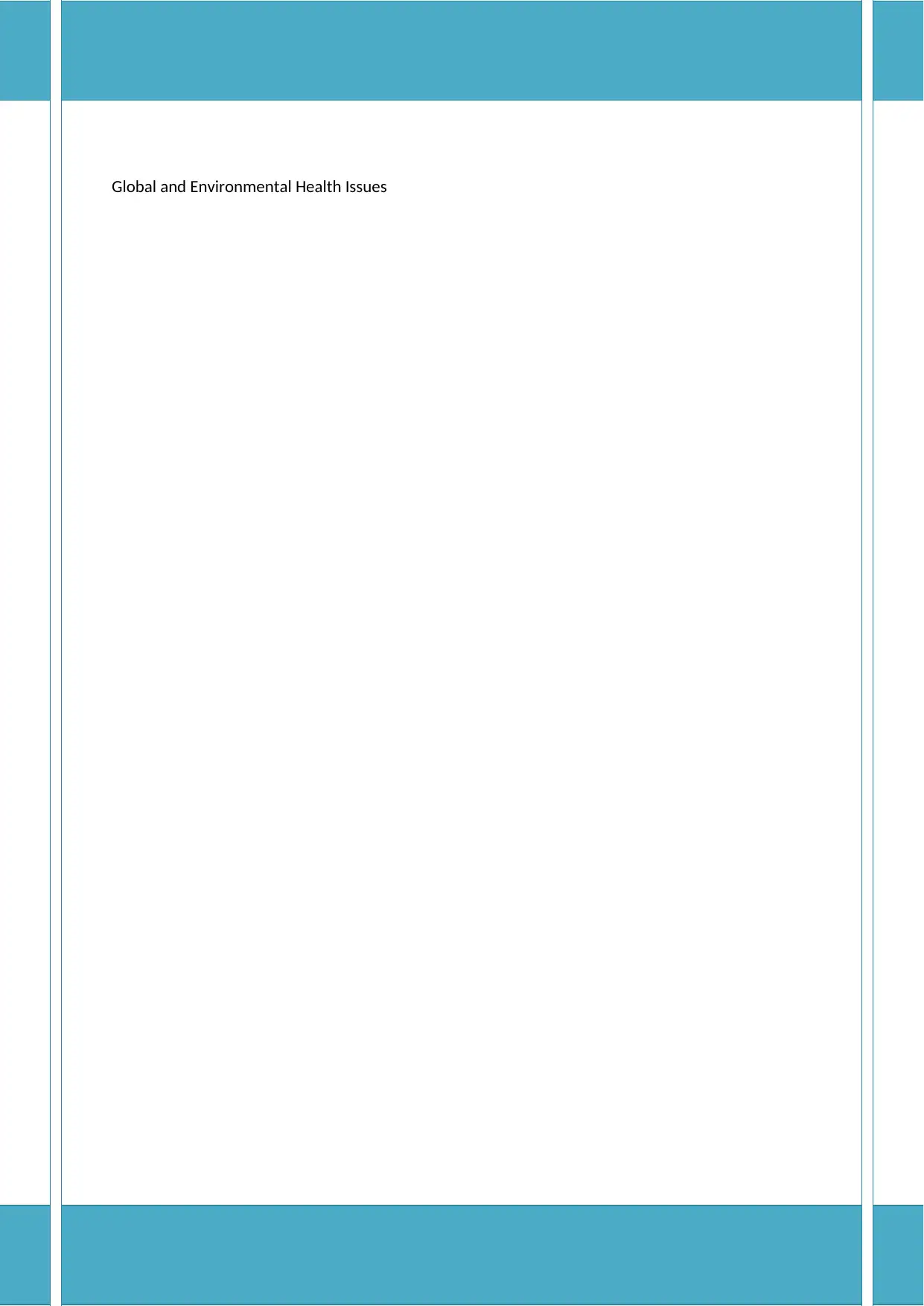
Global and Environmental Health Issues
Paraphrase This Document
Need a fresh take? Get an instant paraphrase of this document with our AI Paraphraser
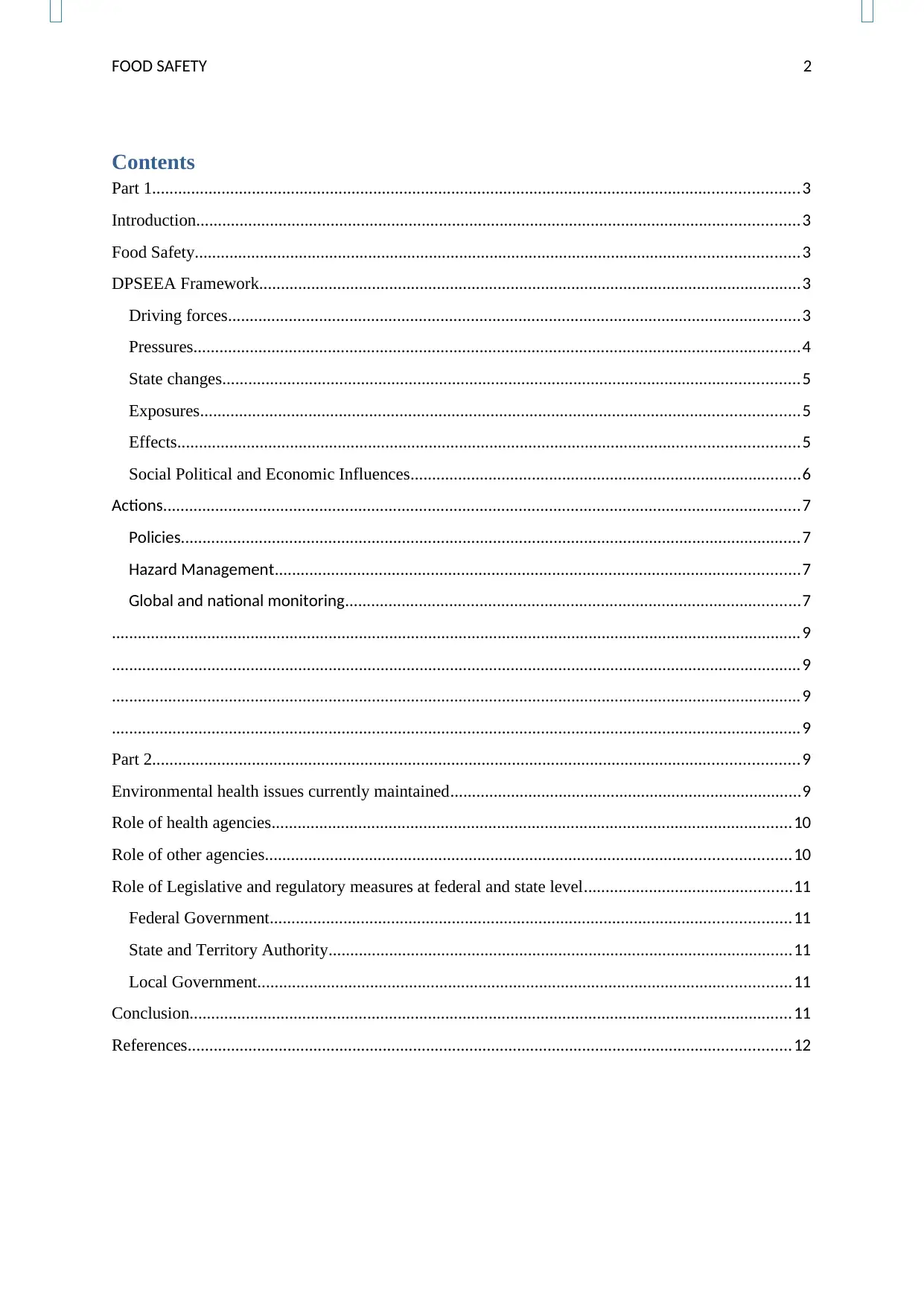
FOOD SAFETY 2
Contents
Part 1.....................................................................................................................................................3
Introduction...........................................................................................................................................3
Food Safety...........................................................................................................................................3
DPSEEA Framework.............................................................................................................................3
Driving forces....................................................................................................................................3
Pressures............................................................................................................................................4
State changes.....................................................................................................................................5
Exposures..........................................................................................................................................5
Effects...............................................................................................................................................5
Social Political and Economic Influences..........................................................................................6
Actions...................................................................................................................................................7
Policies...............................................................................................................................................7
Hazard Management.........................................................................................................................7
Global and national monitoring.........................................................................................................7
...............................................................................................................................................................9
...............................................................................................................................................................9
...............................................................................................................................................................9
...............................................................................................................................................................9
Part 2.....................................................................................................................................................9
Environmental health issues currently maintained.................................................................................9
Role of health agencies........................................................................................................................10
Role of other agencies.........................................................................................................................10
Role of Legislative and regulatory measures at federal and state level................................................11
Federal Government........................................................................................................................11
State and Territory Authority...........................................................................................................11
Local Government...........................................................................................................................11
Conclusion...........................................................................................................................................11
References...........................................................................................................................................12
Contents
Part 1.....................................................................................................................................................3
Introduction...........................................................................................................................................3
Food Safety...........................................................................................................................................3
DPSEEA Framework.............................................................................................................................3
Driving forces....................................................................................................................................3
Pressures............................................................................................................................................4
State changes.....................................................................................................................................5
Exposures..........................................................................................................................................5
Effects...............................................................................................................................................5
Social Political and Economic Influences..........................................................................................6
Actions...................................................................................................................................................7
Policies...............................................................................................................................................7
Hazard Management.........................................................................................................................7
Global and national monitoring.........................................................................................................7
...............................................................................................................................................................9
...............................................................................................................................................................9
...............................................................................................................................................................9
...............................................................................................................................................................9
Part 2.....................................................................................................................................................9
Environmental health issues currently maintained.................................................................................9
Role of health agencies........................................................................................................................10
Role of other agencies.........................................................................................................................10
Role of Legislative and regulatory measures at federal and state level................................................11
Federal Government........................................................................................................................11
State and Territory Authority...........................................................................................................11
Local Government...........................................................................................................................11
Conclusion...........................................................................................................................................11
References...........................................................................................................................................12
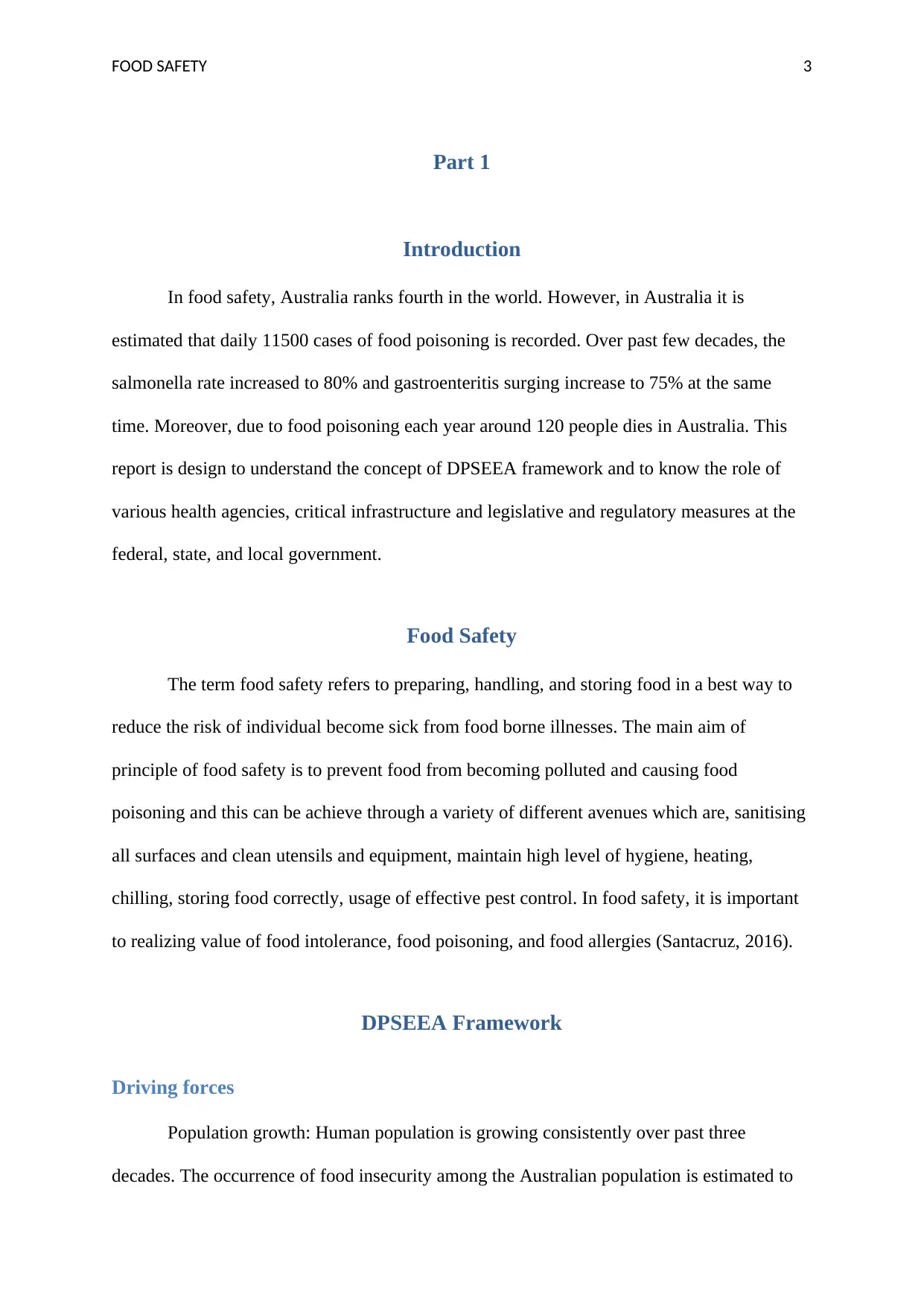
FOOD SAFETY 3
Part 1
Introduction
In food safety, Australia ranks fourth in the world. However, in Australia it is
estimated that daily 11500 cases of food poisoning is recorded. Over past few decades, the
salmonella rate increased to 80% and gastroenteritis surging increase to 75% at the same
time. Moreover, due to food poisoning each year around 120 people dies in Australia. This
report is design to understand the concept of DPSEEA framework and to know the role of
various health agencies, critical infrastructure and legislative and regulatory measures at the
federal, state, and local government.
Food Safety
The term food safety refers to preparing, handling, and storing food in a best way to
reduce the risk of individual become sick from food borne illnesses. The main aim of
principle of food safety is to prevent food from becoming polluted and causing food
poisoning and this can be achieve through a variety of different avenues which are, sanitising
all surfaces and clean utensils and equipment, maintain high level of hygiene, heating,
chilling, storing food correctly, usage of effective pest control. In food safety, it is important
to realizing value of food intolerance, food poisoning, and food allergies (Santacruz, 2016).
DPSEEA Framework
Driving forces
Population growth: Human population is growing consistently over past three
decades. The occurrence of food insecurity among the Australian population is estimated to
Part 1
Introduction
In food safety, Australia ranks fourth in the world. However, in Australia it is
estimated that daily 11500 cases of food poisoning is recorded. Over past few decades, the
salmonella rate increased to 80% and gastroenteritis surging increase to 75% at the same
time. Moreover, due to food poisoning each year around 120 people dies in Australia. This
report is design to understand the concept of DPSEEA framework and to know the role of
various health agencies, critical infrastructure and legislative and regulatory measures at the
federal, state, and local government.
Food Safety
The term food safety refers to preparing, handling, and storing food in a best way to
reduce the risk of individual become sick from food borne illnesses. The main aim of
principle of food safety is to prevent food from becoming polluted and causing food
poisoning and this can be achieve through a variety of different avenues which are, sanitising
all surfaces and clean utensils and equipment, maintain high level of hygiene, heating,
chilling, storing food correctly, usage of effective pest control. In food safety, it is important
to realizing value of food intolerance, food poisoning, and food allergies (Santacruz, 2016).
DPSEEA Framework
Driving forces
Population growth: Human population is growing consistently over past three
decades. The occurrence of food insecurity among the Australian population is estimated to
⊘ This is a preview!⊘
Do you want full access?
Subscribe today to unlock all pages.

Trusted by 1+ million students worldwide
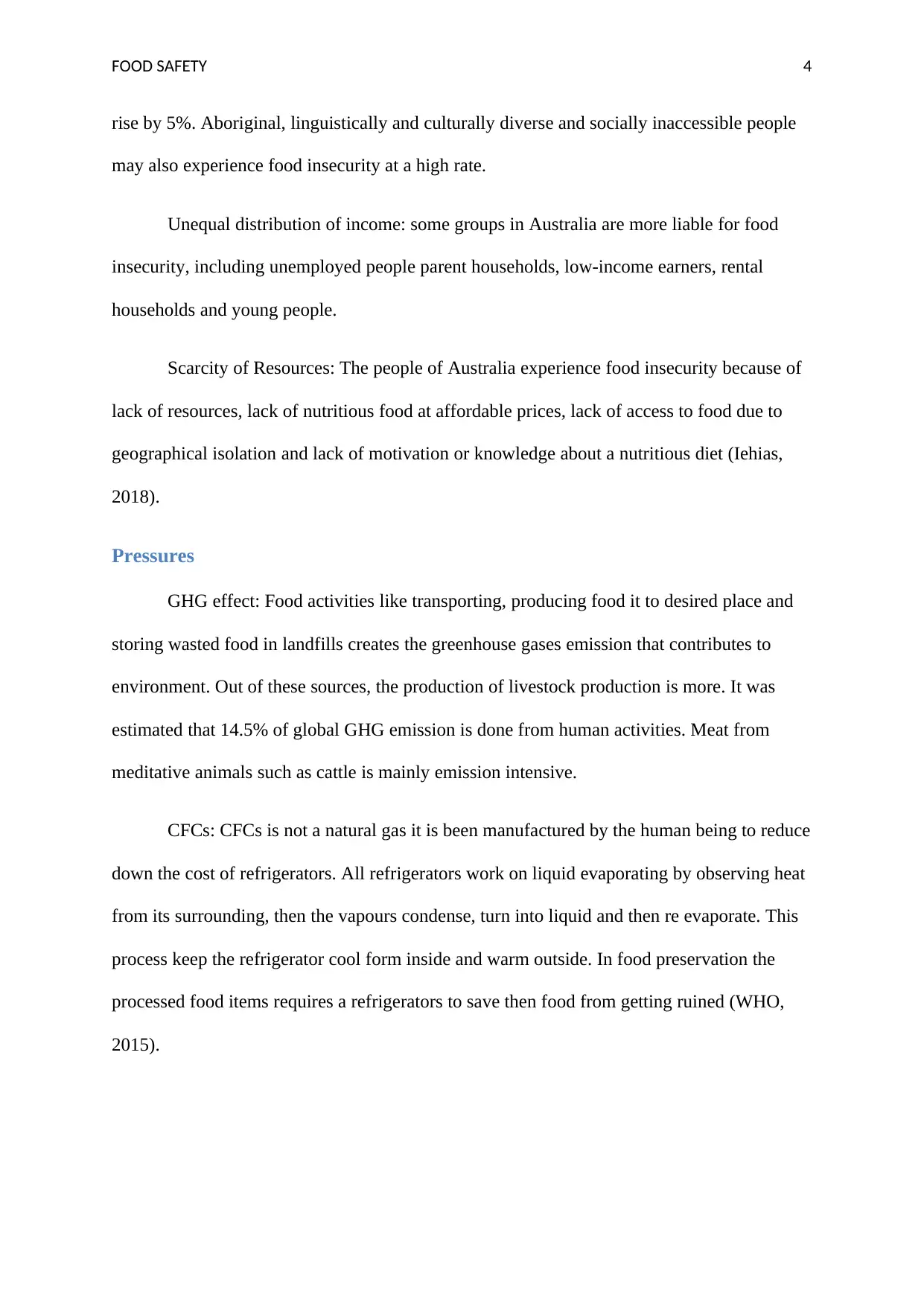
FOOD SAFETY 4
rise by 5%. Aboriginal, linguistically and culturally diverse and socially inaccessible people
may also experience food insecurity at a high rate.
Unequal distribution of income: some groups in Australia are more liable for food
insecurity, including unemployed people parent households, low-income earners, rental
households and young people.
Scarcity of Resources: The people of Australia experience food insecurity because of
lack of resources, lack of nutritious food at affordable prices, lack of access to food due to
geographical isolation and lack of motivation or knowledge about a nutritious diet (Iehias,
2018).
Pressures
GHG effect: Food activities like transporting, producing food it to desired place and
storing wasted food in landfills creates the greenhouse gases emission that contributes to
environment. Out of these sources, the production of livestock production is more. It was
estimated that 14.5% of global GHG emission is done from human activities. Meat from
meditative animals such as cattle is mainly emission intensive.
CFCs: CFCs is not a natural gas it is been manufactured by the human being to reduce
down the cost of refrigerators. All refrigerators work on liquid evaporating by observing heat
from its surrounding, then the vapours condense, turn into liquid and then re evaporate. This
process keep the refrigerator cool form inside and warm outside. In food preservation the
processed food items requires a refrigerators to save then food from getting ruined (WHO,
2015).
rise by 5%. Aboriginal, linguistically and culturally diverse and socially inaccessible people
may also experience food insecurity at a high rate.
Unequal distribution of income: some groups in Australia are more liable for food
insecurity, including unemployed people parent households, low-income earners, rental
households and young people.
Scarcity of Resources: The people of Australia experience food insecurity because of
lack of resources, lack of nutritious food at affordable prices, lack of access to food due to
geographical isolation and lack of motivation or knowledge about a nutritious diet (Iehias,
2018).
Pressures
GHG effect: Food activities like transporting, producing food it to desired place and
storing wasted food in landfills creates the greenhouse gases emission that contributes to
environment. Out of these sources, the production of livestock production is more. It was
estimated that 14.5% of global GHG emission is done from human activities. Meat from
meditative animals such as cattle is mainly emission intensive.
CFCs: CFCs is not a natural gas it is been manufactured by the human being to reduce
down the cost of refrigerators. All refrigerators work on liquid evaporating by observing heat
from its surrounding, then the vapours condense, turn into liquid and then re evaporate. This
process keep the refrigerator cool form inside and warm outside. In food preservation the
processed food items requires a refrigerators to save then food from getting ruined (WHO,
2015).
Paraphrase This Document
Need a fresh take? Get an instant paraphrase of this document with our AI Paraphraser
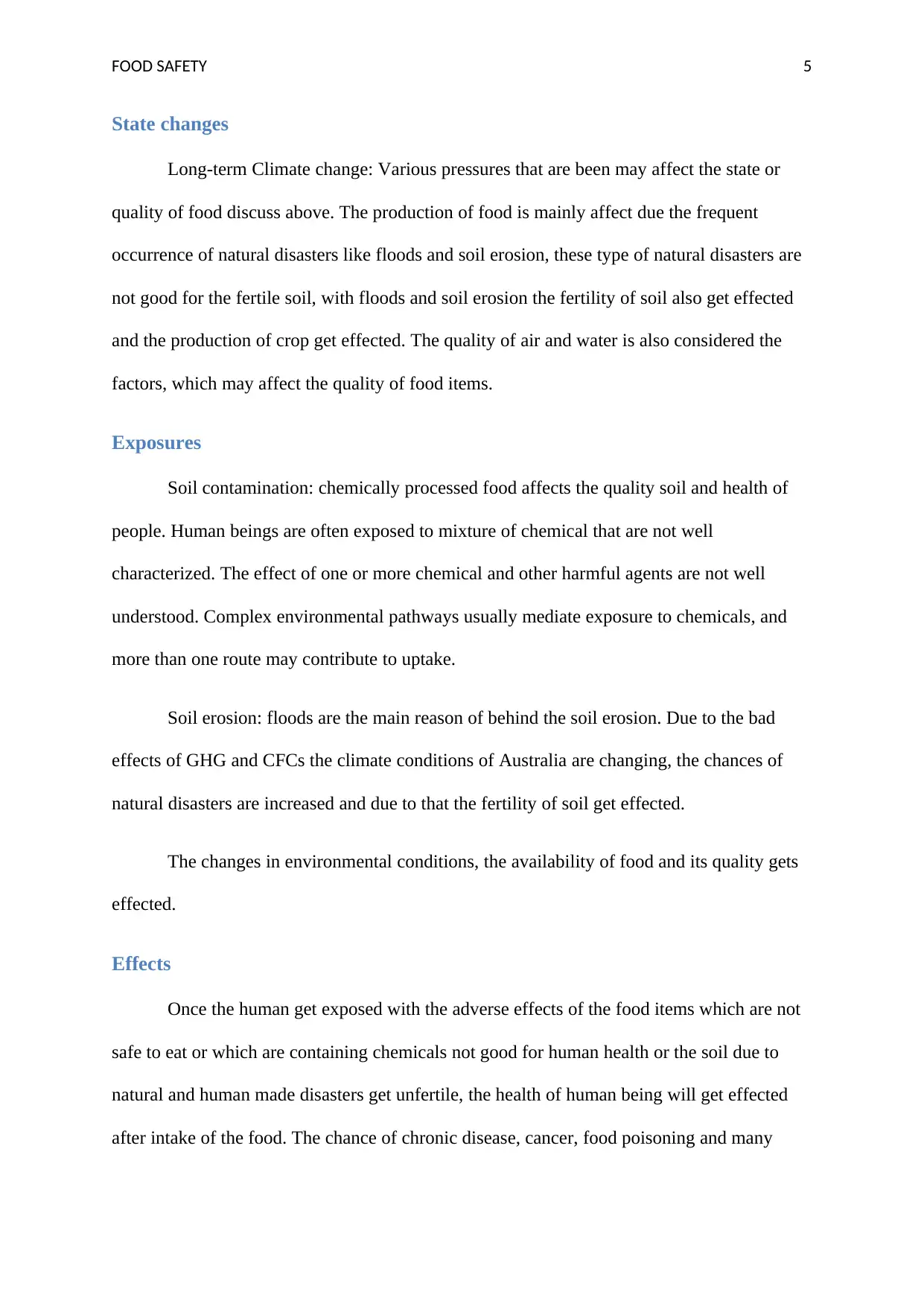
FOOD SAFETY 5
State changes
Long-term Climate change: Various pressures that are been may affect the state or
quality of food discuss above. The production of food is mainly affect due the frequent
occurrence of natural disasters like floods and soil erosion, these type of natural disasters are
not good for the fertile soil, with floods and soil erosion the fertility of soil also get effected
and the production of crop get effected. The quality of air and water is also considered the
factors, which may affect the quality of food items.
Exposures
Soil contamination: chemically processed food affects the quality soil and health of
people. Human beings are often exposed to mixture of chemical that are not well
characterized. The effect of one or more chemical and other harmful agents are not well
understood. Complex environmental pathways usually mediate exposure to chemicals, and
more than one route may contribute to uptake.
Soil erosion: floods are the main reason of behind the soil erosion. Due to the bad
effects of GHG and CFCs the climate conditions of Australia are changing, the chances of
natural disasters are increased and due to that the fertility of soil get effected.
The changes in environmental conditions, the availability of food and its quality gets
effected.
Effects
Once the human get exposed with the adverse effects of the food items which are not
safe to eat or which are containing chemicals not good for human health or the soil due to
natural and human made disasters get unfertile, the health of human being will get effected
after intake of the food. The chance of chronic disease, cancer, food poisoning and many
State changes
Long-term Climate change: Various pressures that are been may affect the state or
quality of food discuss above. The production of food is mainly affect due the frequent
occurrence of natural disasters like floods and soil erosion, these type of natural disasters are
not good for the fertile soil, with floods and soil erosion the fertility of soil also get effected
and the production of crop get effected. The quality of air and water is also considered the
factors, which may affect the quality of food items.
Exposures
Soil contamination: chemically processed food affects the quality soil and health of
people. Human beings are often exposed to mixture of chemical that are not well
characterized. The effect of one or more chemical and other harmful agents are not well
understood. Complex environmental pathways usually mediate exposure to chemicals, and
more than one route may contribute to uptake.
Soil erosion: floods are the main reason of behind the soil erosion. Due to the bad
effects of GHG and CFCs the climate conditions of Australia are changing, the chances of
natural disasters are increased and due to that the fertility of soil get effected.
The changes in environmental conditions, the availability of food and its quality gets
effected.
Effects
Once the human get exposed with the adverse effects of the food items which are not
safe to eat or which are containing chemicals not good for human health or the soil due to
natural and human made disasters get unfertile, the health of human being will get effected
after intake of the food. The chance of chronic disease, cancer, food poisoning and many
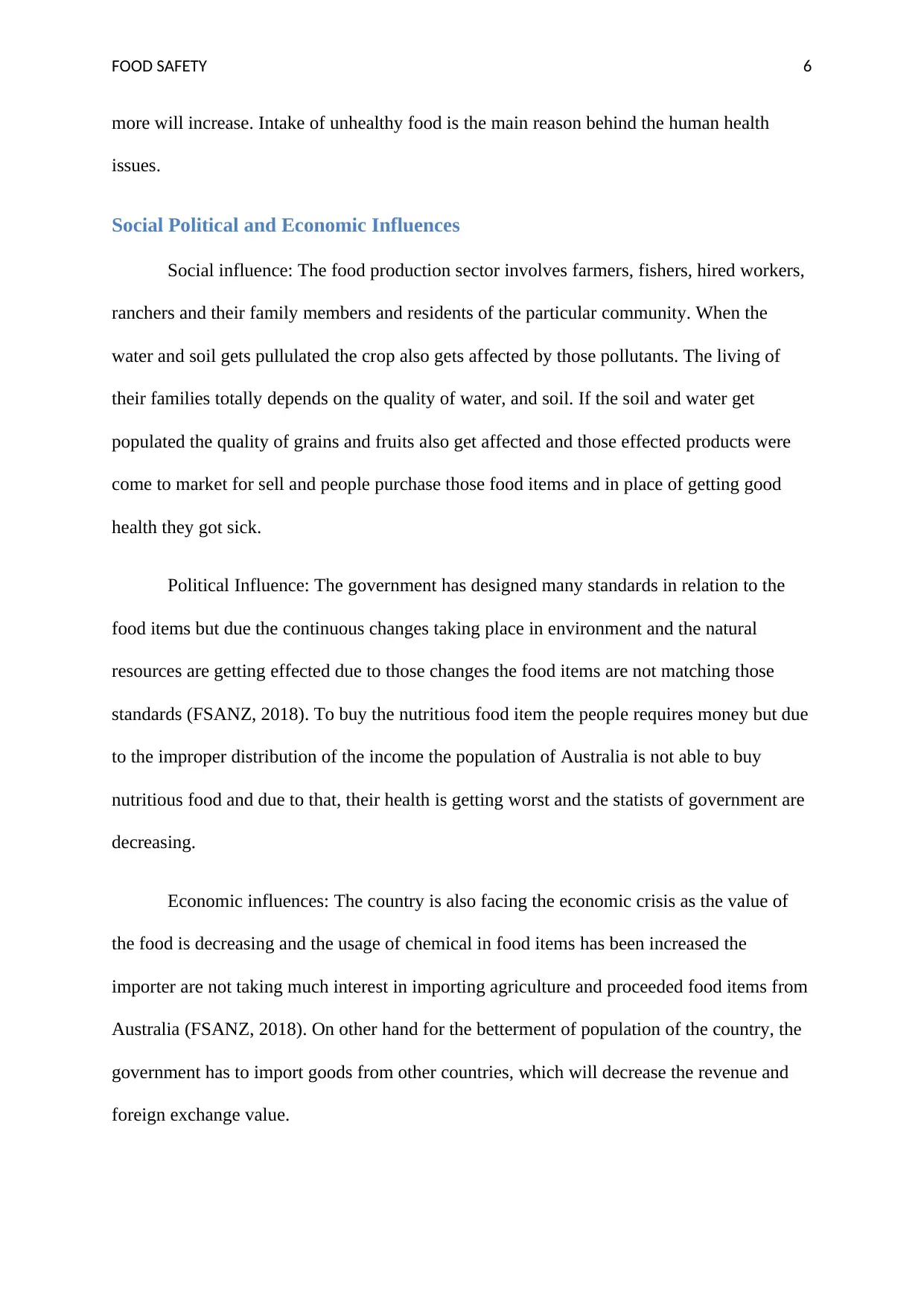
FOOD SAFETY 6
more will increase. Intake of unhealthy food is the main reason behind the human health
issues.
Social Political and Economic Influences
Social influence: The food production sector involves farmers, fishers, hired workers,
ranchers and their family members and residents of the particular community. When the
water and soil gets pullulated the crop also gets affected by those pollutants. The living of
their families totally depends on the quality of water, and soil. If the soil and water get
populated the quality of grains and fruits also get affected and those effected products were
come to market for sell and people purchase those food items and in place of getting good
health they got sick.
Political Influence: The government has designed many standards in relation to the
food items but due the continuous changes taking place in environment and the natural
resources are getting effected due to those changes the food items are not matching those
standards (FSANZ, 2018). To buy the nutritious food item the people requires money but due
to the improper distribution of the income the population of Australia is not able to buy
nutritious food and due to that, their health is getting worst and the statists of government are
decreasing.
Economic influences: The country is also facing the economic crisis as the value of
the food is decreasing and the usage of chemical in food items has been increased the
importer are not taking much interest in importing agriculture and proceeded food items from
Australia (FSANZ, 2018). On other hand for the betterment of population of the country, the
government has to import goods from other countries, which will decrease the revenue and
foreign exchange value.
more will increase. Intake of unhealthy food is the main reason behind the human health
issues.
Social Political and Economic Influences
Social influence: The food production sector involves farmers, fishers, hired workers,
ranchers and their family members and residents of the particular community. When the
water and soil gets pullulated the crop also gets affected by those pollutants. The living of
their families totally depends on the quality of water, and soil. If the soil and water get
populated the quality of grains and fruits also get affected and those effected products were
come to market for sell and people purchase those food items and in place of getting good
health they got sick.
Political Influence: The government has designed many standards in relation to the
food items but due the continuous changes taking place in environment and the natural
resources are getting effected due to those changes the food items are not matching those
standards (FSANZ, 2018). To buy the nutritious food item the people requires money but due
to the improper distribution of the income the population of Australia is not able to buy
nutritious food and due to that, their health is getting worst and the statists of government are
decreasing.
Economic influences: The country is also facing the economic crisis as the value of
the food is decreasing and the usage of chemical in food items has been increased the
importer are not taking much interest in importing agriculture and proceeded food items from
Australia (FSANZ, 2018). On other hand for the betterment of population of the country, the
government has to import goods from other countries, which will decrease the revenue and
foreign exchange value.
⊘ This is a preview!⊘
Do you want full access?
Subscribe today to unlock all pages.

Trusted by 1+ million students worldwide
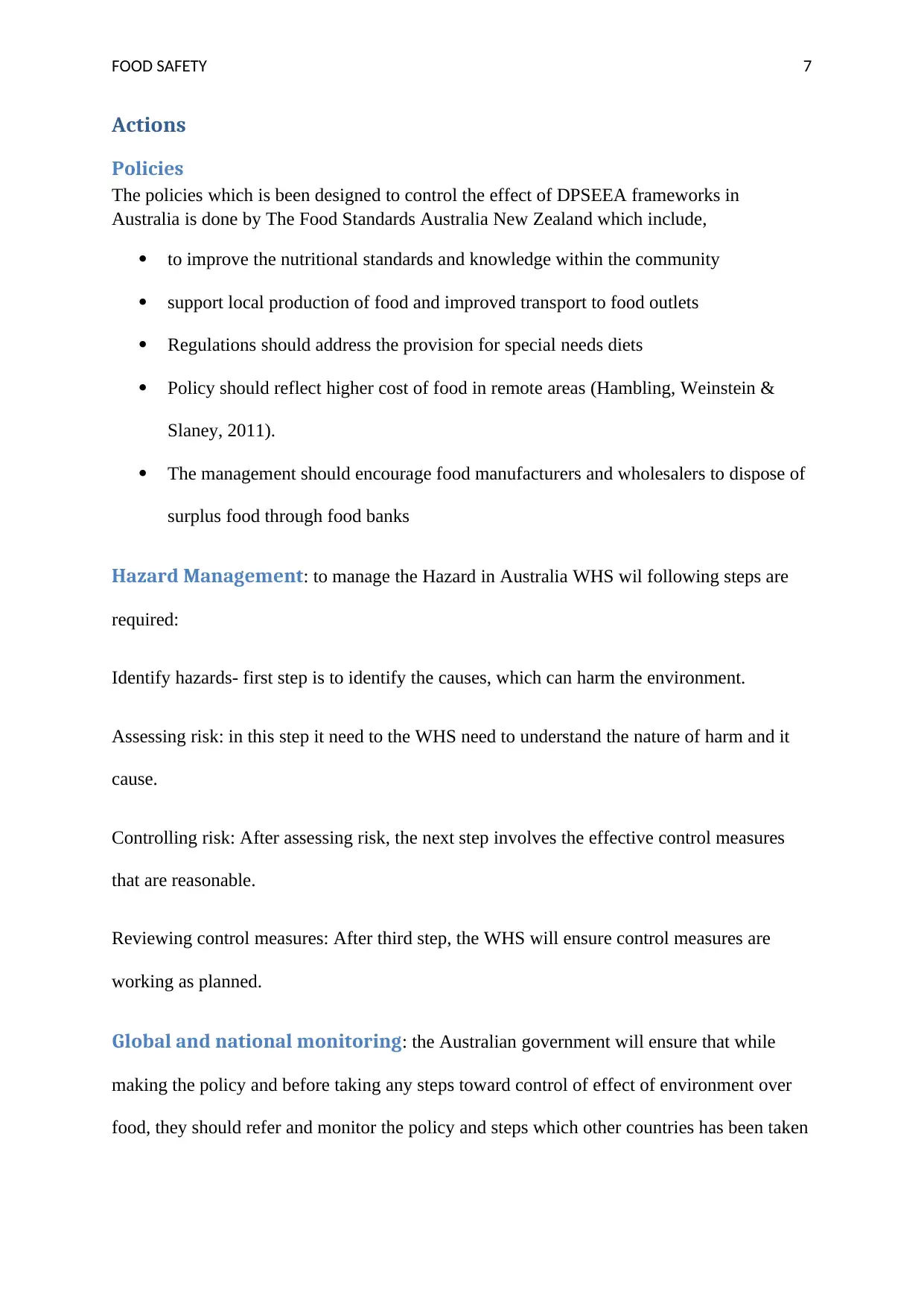
FOOD SAFETY 7
Actions
Policies
The policies which is been designed to control the effect of DPSEEA frameworks in
Australia is done by The Food Standards Australia New Zealand which include,
to improve the nutritional standards and knowledge within the community
support local production of food and improved transport to food outlets
Regulations should address the provision for special needs diets
Policy should reflect higher cost of food in remote areas (Hambling, Weinstein &
Slaney, 2011).
The management should encourage food manufacturers and wholesalers to dispose of
surplus food through food banks
Hazard Management: to manage the Hazard in Australia WHS wil following steps are
required:
Identify hazards- first step is to identify the causes, which can harm the environment.
Assessing risk: in this step it need to the WHS need to understand the nature of harm and it
cause.
Controlling risk: After assessing risk, the next step involves the effective control measures
that are reasonable.
Reviewing control measures: After third step, the WHS will ensure control measures are
working as planned.
Global and national monitoring: the Australian government will ensure that while
making the policy and before taking any steps toward control of effect of environment over
food, they should refer and monitor the policy and steps which other countries has been taken
Actions
Policies
The policies which is been designed to control the effect of DPSEEA frameworks in
Australia is done by The Food Standards Australia New Zealand which include,
to improve the nutritional standards and knowledge within the community
support local production of food and improved transport to food outlets
Regulations should address the provision for special needs diets
Policy should reflect higher cost of food in remote areas (Hambling, Weinstein &
Slaney, 2011).
The management should encourage food manufacturers and wholesalers to dispose of
surplus food through food banks
Hazard Management: to manage the Hazard in Australia WHS wil following steps are
required:
Identify hazards- first step is to identify the causes, which can harm the environment.
Assessing risk: in this step it need to the WHS need to understand the nature of harm and it
cause.
Controlling risk: After assessing risk, the next step involves the effective control measures
that are reasonable.
Reviewing control measures: After third step, the WHS will ensure control measures are
working as planned.
Global and national monitoring: the Australian government will ensure that while
making the policy and before taking any steps toward control of effect of environment over
food, they should refer and monitor the policy and steps which other countries has been taken
Paraphrase This Document
Need a fresh take? Get an instant paraphrase of this document with our AI Paraphraser
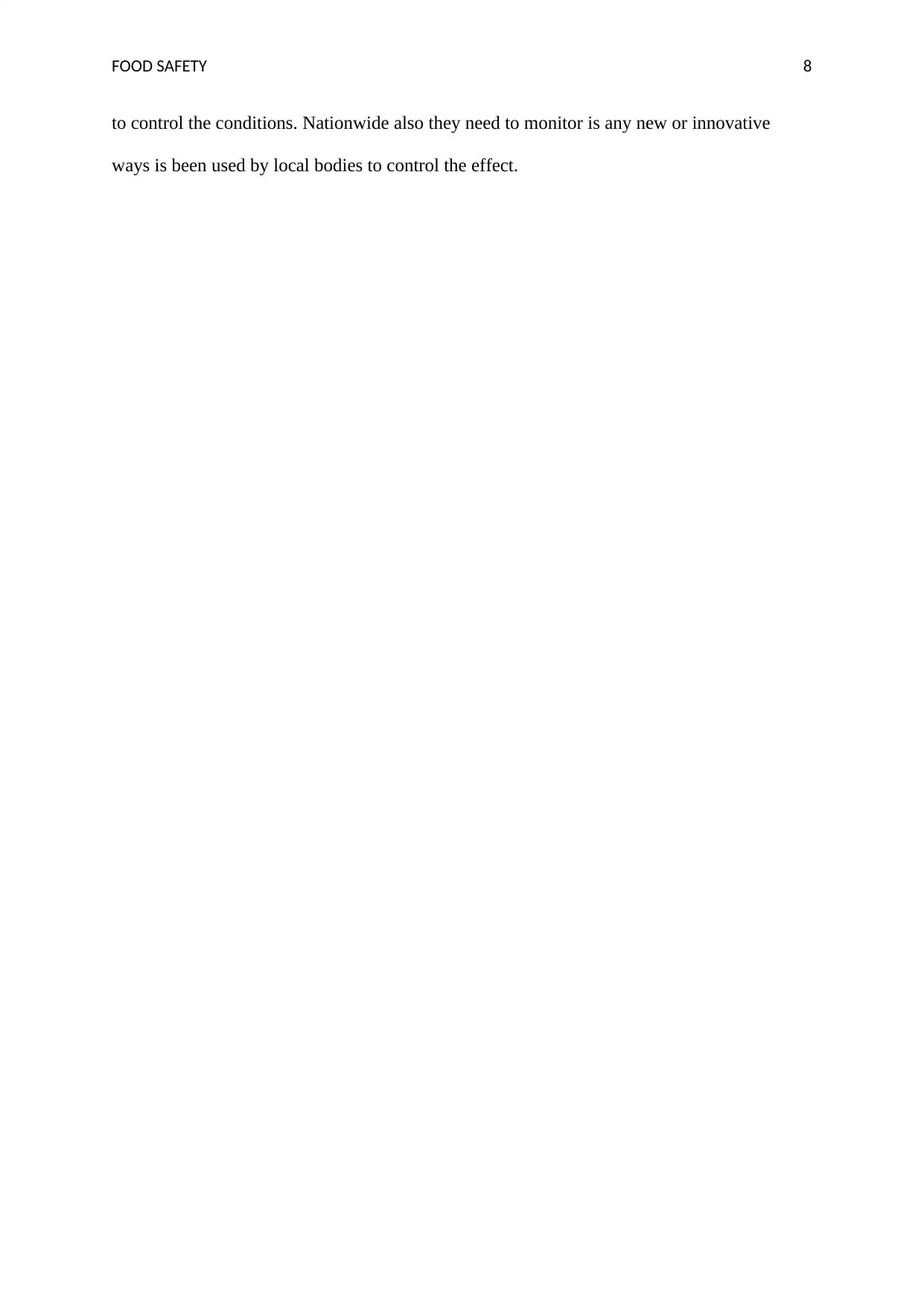
FOOD SAFETY 8
to control the conditions. Nationwide also they need to monitor is any new or innovative
ways is been used by local bodies to control the effect.
to control the conditions. Nationwide also they need to monitor is any new or innovative
ways is been used by local bodies to control the effect.
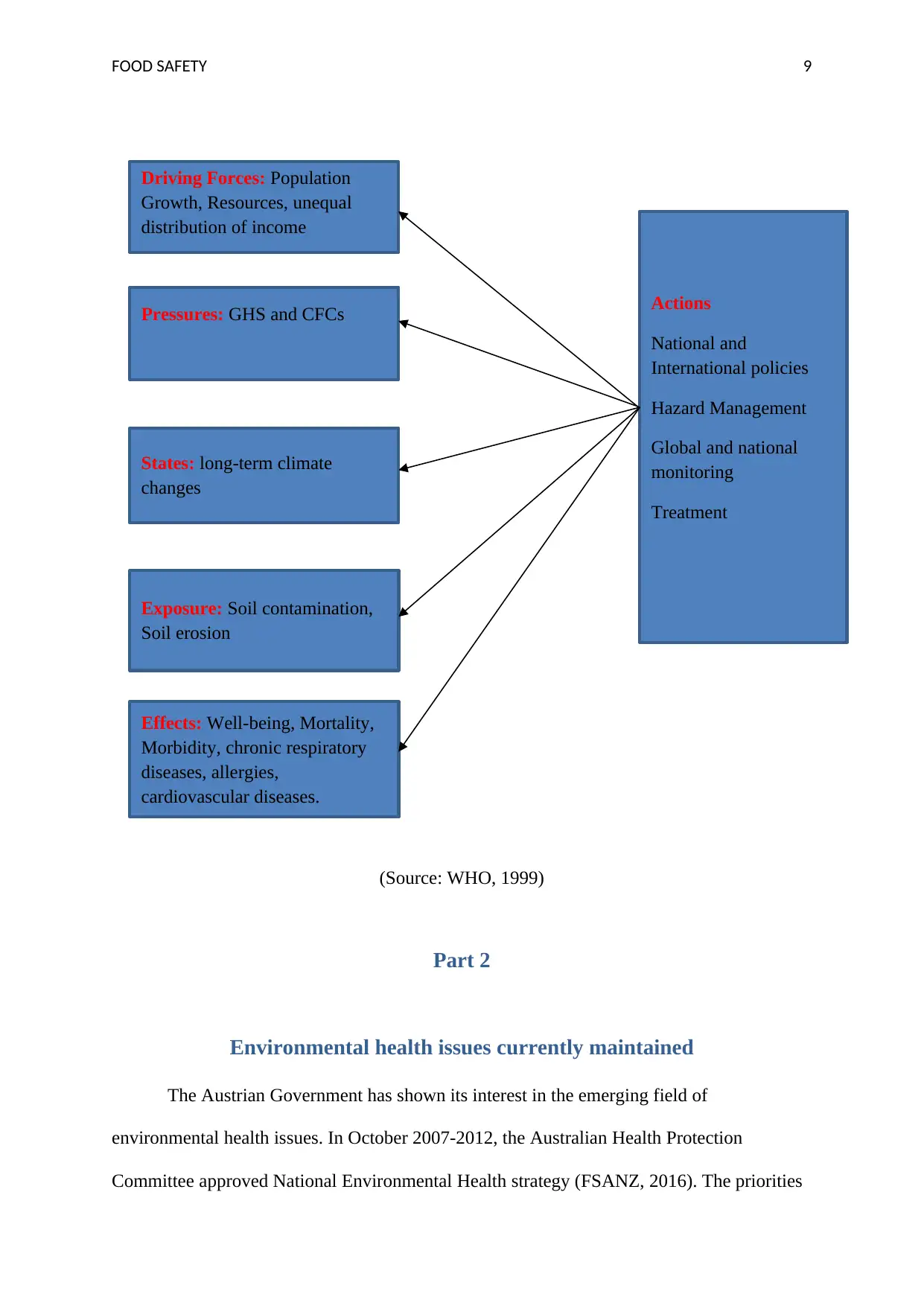
FOOD SAFETY 9
(Source: WHO, 1999)
Part 2
Environmental health issues currently maintained
The Austrian Government has shown its interest in the emerging field of
environmental health issues. In October 2007-2012, the Australian Health Protection
Committee approved National Environmental Health strategy (FSANZ, 2016). The priorities
Driving Forces: Population
Growth, Resources, unequal
distribution of income
Pressures: GHS and CFCs
States: long-term climate
changes
Exposure: Soil contamination,
Soil erosion
Effects: Well-being, Mortality,
Morbidity, chronic respiratory
diseases, allergies,
cardiovascular diseases.
Actions
National and
International policies
Hazard Management
Global and national
monitoring
Treatment
(Source: WHO, 1999)
Part 2
Environmental health issues currently maintained
The Austrian Government has shown its interest in the emerging field of
environmental health issues. In October 2007-2012, the Australian Health Protection
Committee approved National Environmental Health strategy (FSANZ, 2016). The priorities
Driving Forces: Population
Growth, Resources, unequal
distribution of income
Pressures: GHS and CFCs
States: long-term climate
changes
Exposure: Soil contamination,
Soil erosion
Effects: Well-being, Mortality,
Morbidity, chronic respiratory
diseases, allergies,
cardiovascular diseases.
Actions
National and
International policies
Hazard Management
Global and national
monitoring
Treatment
⊘ This is a preview!⊘
Do you want full access?
Subscribe today to unlock all pages.

Trusted by 1+ million students worldwide
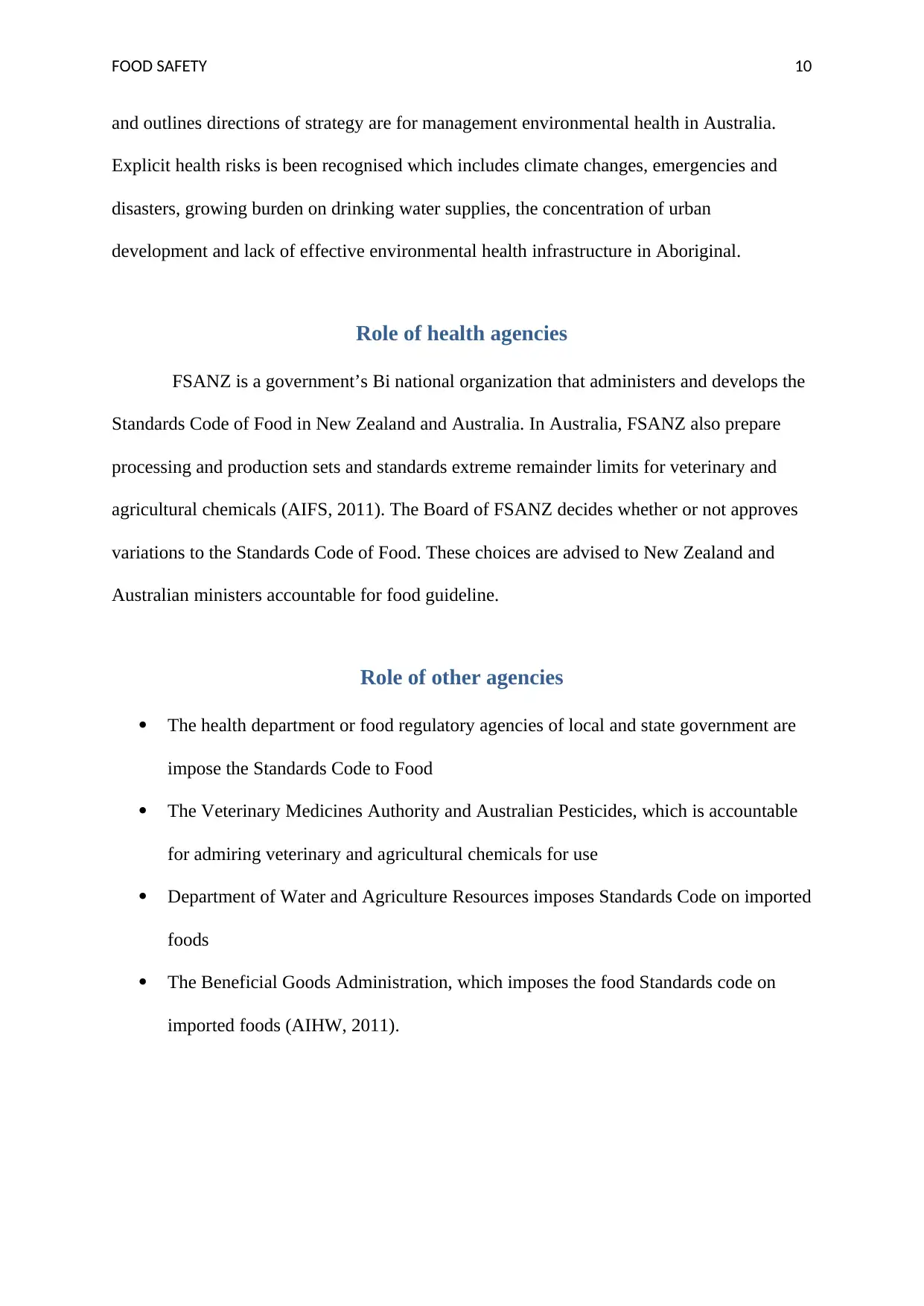
FOOD SAFETY 10
and outlines directions of strategy are for management environmental health in Australia.
Explicit health risks is been recognised which includes climate changes, emergencies and
disasters, growing burden on drinking water supplies, the concentration of urban
development and lack of effective environmental health infrastructure in Aboriginal.
Role of health agencies
FSANZ is a government’s Bi national organization that administers and develops the
Standards Code of Food in New Zealand and Australia. In Australia, FSANZ also prepare
processing and production sets and standards extreme remainder limits for veterinary and
agricultural chemicals (AIFS, 2011). The Board of FSANZ decides whether or not approves
variations to the Standards Code of Food. These choices are advised to New Zealand and
Australian ministers accountable for food guideline.
Role of other agencies
The health department or food regulatory agencies of local and state government are
impose the Standards Code to Food
The Veterinary Medicines Authority and Australian Pesticides, which is accountable
for admiring veterinary and agricultural chemicals for use
Department of Water and Agriculture Resources imposes Standards Code on imported
foods
The Beneficial Goods Administration, which imposes the food Standards code on
imported foods (AIHW, 2011).
and outlines directions of strategy are for management environmental health in Australia.
Explicit health risks is been recognised which includes climate changes, emergencies and
disasters, growing burden on drinking water supplies, the concentration of urban
development and lack of effective environmental health infrastructure in Aboriginal.
Role of health agencies
FSANZ is a government’s Bi national organization that administers and develops the
Standards Code of Food in New Zealand and Australia. In Australia, FSANZ also prepare
processing and production sets and standards extreme remainder limits for veterinary and
agricultural chemicals (AIFS, 2011). The Board of FSANZ decides whether or not approves
variations to the Standards Code of Food. These choices are advised to New Zealand and
Australian ministers accountable for food guideline.
Role of other agencies
The health department or food regulatory agencies of local and state government are
impose the Standards Code to Food
The Veterinary Medicines Authority and Australian Pesticides, which is accountable
for admiring veterinary and agricultural chemicals for use
Department of Water and Agriculture Resources imposes Standards Code on imported
foods
The Beneficial Goods Administration, which imposes the food Standards code on
imported foods (AIHW, 2011).
Paraphrase This Document
Need a fresh take? Get an instant paraphrase of this document with our AI Paraphraser
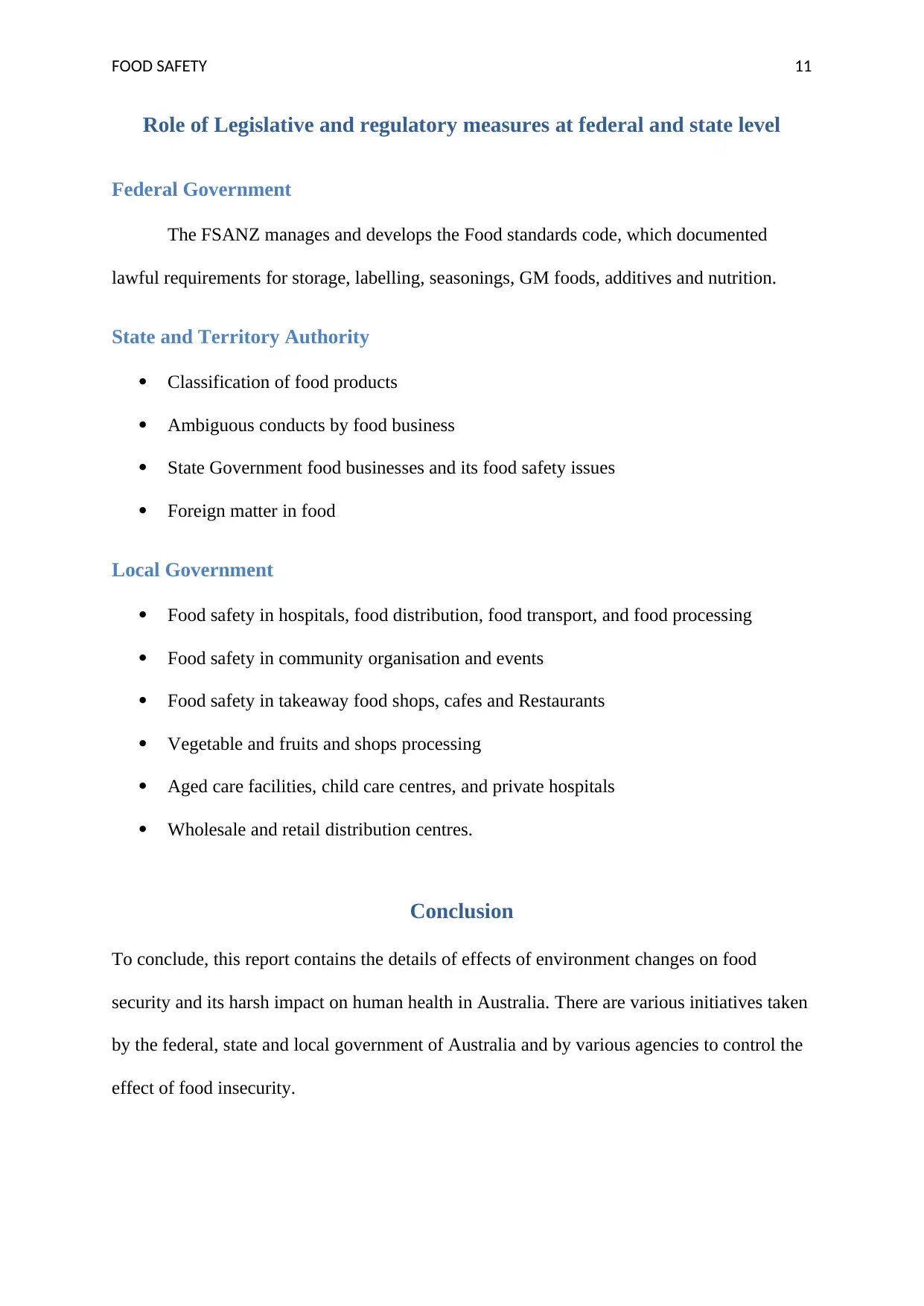
FOOD SAFETY 11
Role of Legislative and regulatory measures at federal and state level
Federal Government
The FSANZ manages and develops the Food standards code, which documented
lawful requirements for storage, labelling, seasonings, GM foods, additives and nutrition.
State and Territory Authority
Classification of food products
Ambiguous conducts by food business
State Government food businesses and its food safety issues
Foreign matter in food
Local Government
Food safety in hospitals, food distribution, food transport, and food processing
Food safety in community organisation and events
Food safety in takeaway food shops, cafes and Restaurants
Vegetable and fruits and shops processing
Aged care facilities, child care centres, and private hospitals
Wholesale and retail distribution centres.
Conclusion
To conclude, this report contains the details of effects of environment changes on food
security and its harsh impact on human health in Australia. There are various initiatives taken
by the federal, state and local government of Australia and by various agencies to control the
effect of food insecurity.
Role of Legislative and regulatory measures at federal and state level
Federal Government
The FSANZ manages and develops the Food standards code, which documented
lawful requirements for storage, labelling, seasonings, GM foods, additives and nutrition.
State and Territory Authority
Classification of food products
Ambiguous conducts by food business
State Government food businesses and its food safety issues
Foreign matter in food
Local Government
Food safety in hospitals, food distribution, food transport, and food processing
Food safety in community organisation and events
Food safety in takeaway food shops, cafes and Restaurants
Vegetable and fruits and shops processing
Aged care facilities, child care centres, and private hospitals
Wholesale and retail distribution centres.
Conclusion
To conclude, this report contains the details of effects of environment changes on food
security and its harsh impact on human health in Australia. There are various initiatives taken
by the federal, state and local government of Australia and by various agencies to control the
effect of food insecurity.
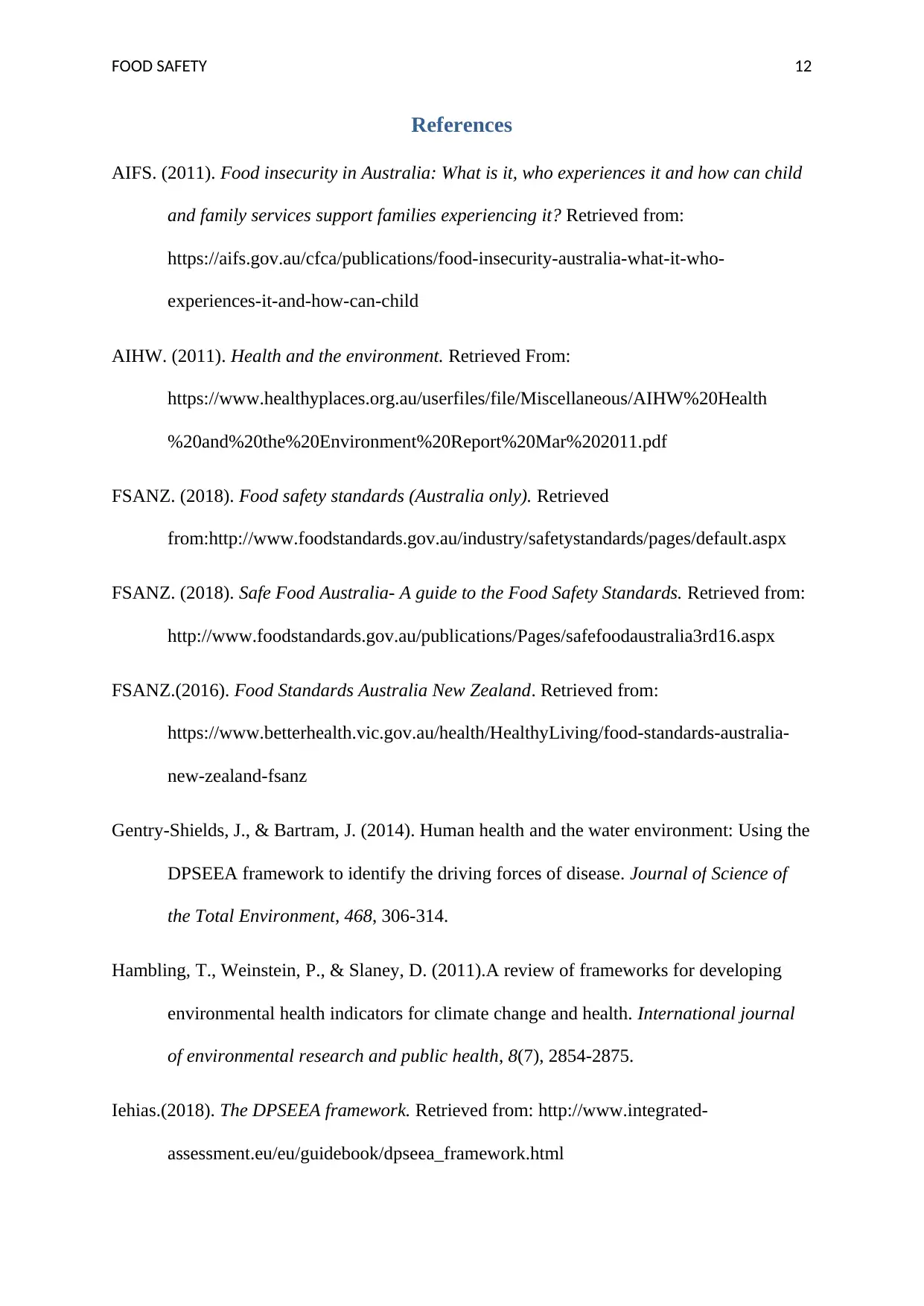
FOOD SAFETY 12
References
AIFS. (2011). Food insecurity in Australia: What is it, who experiences it and how can child
and family services support families experiencing it? Retrieved from:
https://aifs.gov.au/cfca/publications/food-insecurity-australia-what-it-who-
experiences-it-and-how-can-child
AIHW. (2011). Health and the environment. Retrieved From:
https://www.healthyplaces.org.au/userfiles/file/Miscellaneous/AIHW%20Health
%20and%20the%20Environment%20Report%20Mar%202011.pdf
FSANZ. (2018). Food safety standards (Australia only). Retrieved
from:http://www.foodstandards.gov.au/industry/safetystandards/pages/default.aspx
FSANZ. (2018). Safe Food Australia- A guide to the Food Safety Standards. Retrieved from:
http://www.foodstandards.gov.au/publications/Pages/safefoodaustralia3rd16.aspx
FSANZ.(2016). Food Standards Australia New Zealand. Retrieved from:
https://www.betterhealth.vic.gov.au/health/HealthyLiving/food-standards-australia-
new-zealand-fsanz
Gentry-Shields, J., & Bartram, J. (2014). Human health and the water environment: Using the
DPSEEA framework to identify the driving forces of disease. Journal of Science of
the Total Environment, 468, 306-314.
Hambling, T., Weinstein, P., & Slaney, D. (2011).A review of frameworks for developing
environmental health indicators for climate change and health. International journal
of environmental research and public health, 8(7), 2854-2875.
Iehias.(2018). The DPSEEA framework. Retrieved from: http://www.integrated-
assessment.eu/eu/guidebook/dpseea_framework.html
References
AIFS. (2011). Food insecurity in Australia: What is it, who experiences it and how can child
and family services support families experiencing it? Retrieved from:
https://aifs.gov.au/cfca/publications/food-insecurity-australia-what-it-who-
experiences-it-and-how-can-child
AIHW. (2011). Health and the environment. Retrieved From:
https://www.healthyplaces.org.au/userfiles/file/Miscellaneous/AIHW%20Health
%20and%20the%20Environment%20Report%20Mar%202011.pdf
FSANZ. (2018). Food safety standards (Australia only). Retrieved
from:http://www.foodstandards.gov.au/industry/safetystandards/pages/default.aspx
FSANZ. (2018). Safe Food Australia- A guide to the Food Safety Standards. Retrieved from:
http://www.foodstandards.gov.au/publications/Pages/safefoodaustralia3rd16.aspx
FSANZ.(2016). Food Standards Australia New Zealand. Retrieved from:
https://www.betterhealth.vic.gov.au/health/HealthyLiving/food-standards-australia-
new-zealand-fsanz
Gentry-Shields, J., & Bartram, J. (2014). Human health and the water environment: Using the
DPSEEA framework to identify the driving forces of disease. Journal of Science of
the Total Environment, 468, 306-314.
Hambling, T., Weinstein, P., & Slaney, D. (2011).A review of frameworks for developing
environmental health indicators for climate change and health. International journal
of environmental research and public health, 8(7), 2854-2875.
Iehias.(2018). The DPSEEA framework. Retrieved from: http://www.integrated-
assessment.eu/eu/guidebook/dpseea_framework.html
⊘ This is a preview!⊘
Do you want full access?
Subscribe today to unlock all pages.

Trusted by 1+ million students worldwide
1 out of 13
Your All-in-One AI-Powered Toolkit for Academic Success.
+13062052269
info@desklib.com
Available 24*7 on WhatsApp / Email
![[object Object]](/_next/static/media/star-bottom.7253800d.svg)
Unlock your academic potential
Copyright © 2020–2025 A2Z Services. All Rights Reserved. Developed and managed by ZUCOL.


